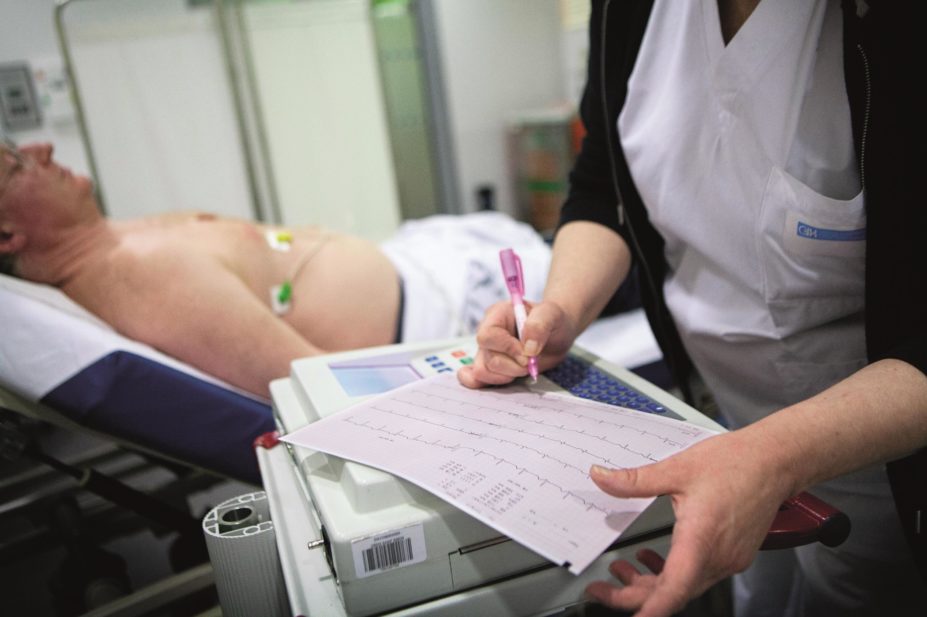
BSIP SA / Alamy Stock Photo
Acute coronary syndrome (ACS) is used to describe a range of acute myocardial ischaemias, where reduced blood flow to the coronary arteries, usually caused by an acute plaque event leading to an obstruction, results in myocardial infarction (MI). ACS is a term used as a working diagnosis to cover a spectrum of myocardial ischaemia, including ST-segment elevation myocardial infarction (STEMI), in which there is complete blockage of a coronary artery, and non-ST elevation myocardial infarction (NSTEMI) and unstable angina (UA), where a partial blockage of the artery occurs.
As UA and NSTEMI often have identical clinical presentation, they are collectively termed non-ST elevation acute coronary syndrome (NSTE-ACS) in the latest guidance from the American College of Cardiology (ACC) and American Heart Association (AHA)[1]
. Similar to the term ACS, this is a collective term recognising the similarities in presentation and outcome in patients presenting with NSTEMI and high risk UA.
Clinical history, physical examination, electrocardiogram (ECG) changes and biochemical markers of myocardial necrosis (e.g. troponin) are all used to identify patients with suspected NSTE-ACS[2]
.
This article discusses risk stratification and ongoing care following NSTE-ACS, focusing on patients identified as at low risk of adverse outcomes.
Risk stratification
The AHA/ACC guideline suggests using risk-stratification models to tailor management[1]
.
A n
umber of validated risk stratification tools have been developed and are commonly used in practice.
The Global Registry of Acute Coronary Events (GRACE) score is used to assess the risk of mortality or MI in pati
ents diagnosed with NSTE-ACS[3]
and uses eight clinical variables to risk stratify
patients (see ‘The Global Registry of Acute Coronary Events (GRACE) variables’). To calculate the GRACE score, the patient is assigned a series of points for each of the clinical variables, which is most commonly converted to determine the admission to six month mortality (see ‘Predicted six month mortality and risk of future events’). Patients scoring ≤88 points are deemed to be at low ri
sk (<3%) of death post-discharge to six months, 89–118 is considered to be at interm
ediate risk (3–6%) and >118 is regarded high risk (>6%). When expressing risk in terms of GRACE score, the ACC/AHA guidance uses the risk tool based on adm
ission outcomes[1]
; UK practice using guidance from
the National Institute for Health and Care Excellence (NI
CE)[4]
is to quote admission to six months risk.
| The Global Registry of Acute Coronary Events (GRACE) variables |
|---|
| Source: BMJ 2006;333(7578):1091[3] |
| 1. Age |
| 2. Heart rate |
| 3. Systolic blood pressure |
| 4. Serum creatinine |
| 5. Congestive heart failure: Killip class |
| 6. Cardiac arrest on admission |
| 7. ST-segment deviation |
| 8. Elevated cardiac enzymes/markers |
| Predicted six month mortality and risk of future events | |
|---|---|
| Predicted six month mortality | Risk of future adverse cardiovascular events |
| 1.5% or below | Lowest |
| >1.5% to 3.0% | Low |
| >3.0% to 6.0% | Intermediate |
| >6.0% to 9.0% | High |
| Over 9.0% | Highest |
Other risk stratification tools are also available and include the Thrombolysis in Myocardial Infarction (TIMI) risk score[5] and the Platelet glycoprotein IIb/IIIa in Unstable angina: Receptor Suppression Using Integrilin Tool (PURSUIT)[6]
, which also both predict risk in patients diagnosed with NSTE-ACS.
T
he AHA/ACC guidance does not recommend any one predictor model over the other, while NICE
recommends the GRACE scoring system to risk-stratify patients admitted to hospitals in England and W
ales[4]
. This guid
ance is based on strong correlation between six-month predicted mortality from the international GRACE registry and six month national mortality data derived from the Myocardial Ischaemia National
Audit Project (MINAP)[7]
.
Patients who
present with suspected NSTE-ACS at high risk of adverse outcomes require angiography within 72 hours. The purpose of rapid angiography is to determine coronary anatomy, the extent of any blockages and, w
here indicated, revascularisation with stenting.
Low-
risk patients presenting with NSTE-ACS can be treated conservatively, with treatment guided by their condition. Rapid coronary angiography is only used in low-risk patients if they experience refractory or recurrent ischaemic symptoms despite medical optimisation, or haemodynamic instability. This approach avoids routine early use of costly invasive procedures (e.g. angiography) that will not confer clinical benefit and could result in harm. The AHA/ACC guideline recommends that this conservative approach should be a
dopted for patients deemed at low risk using a risk score, as well as in low-risk troponin-negative
wo
men[1]
.
Immediate management
T
he aim of treatment for all patients presenting with NSTE-ACS is immediate symptomatic relief of isc
haemia and preventing further MI and death[8]
.
Sta
ndard medical therapy includes sublingual (e.g. glyceryl trinitrate 400mcg spray: 1–2 puffs) or intravenous nitrates (glyceryl trinitrate: 1–10mg/hr) for persistent ischaemic pain. Nitrates cause vasodilation, decreasing cardiac preload and reducing ventricular wall tension. Morphine can also be used given its vasodilatory properties and modest reductions in heart rate (through increased vagal tone) and systol
ic blood pressure[8]
.
Oral be
ta-blockers should be started within the first 24 hours provided blood pressure and heart rate allow (i.e. systolic blood pressures >100mmHg and heart rate >60 beats per minute). It is common practice to initiate a short acting beta-blocker such as metoprolol 12.5–25mg three times daily to assess response, then switch to a once daily beta-blocker such as bisoprolol 5–10mg daily within one to two days. Beta-blockers are introduced to prevent sudden cardiac death associated with the development of complex ventricular arrhythmias and to decrease blood pressure, heart rate and contractility, leading to a reduction in myocardi
al oxygen consumption, myocardial ischaemia and reinfarction[8]
.
F
or patients with contraindications or severe side effects to beta blockers, such as shortness of breath on initiation and those with severe peripheral vascular disease, a non-dihydropyridine calcium channel blocker (diltiazem or verapamil) can be given instead. Diltiazem is initiated at 60mg three times daily and titrated to response, up to a usual maximum dose of 360mg daily, this can be given in divided doses or a long acting preparation can be used. Similarly, verapamil can be started at 40–80mg three times a day and increased according to response, up to a daily dose of 360–480mg, depending on the preparation us
ed[8]
.
A single
dose of non–enteric-coated, chewable aspirin (162–325mg) should be given to all patients with NSTE-ACS as soon as possible after presentation, and a maintenance dose of aspirin (81–162mg daily) should be
continued indefinitely[1]
. NICE r
ecommends patients are initially given aspirin 300mg as a loading dose
, followed by a daily maintenanc
e dose of 75mg[4]
. The AHA/ACC
guidance makes reference to evaluating a patient’s bleeding risk and ensuring that, where relative contraindications to antiplatelet therapy exist (e.g. low platelet count, active bleeding, recent operations), a risk-benefit analysis of antiplatelet treatment is taken into ac
count[1]
.
AC
C/AHA recommend ticagrelor in combination with aspirin to be taken for up to 12 months in patients pre
senting with NSTE-ACS[1]
; in UK practice, ticagrelor in this setting is suggested as an option as per NICE TA236[4]
. For th
ose patients who are at high risk and undergo immediate percutaneous coronary intervention, either prasugrel or ticagrelor remain an option over clopidogrel in combination with aspirin for up to one ye
ar[1]
,[4]
. The more po
tent antiplatelets, ticagrelor and prasugrel, have shown increased non-bypass related major bleeding i
n their pivotal studies over clopidogel[9]
,
[10]
, so for those de
emed at high risk of bleeding, clopidogrel may be a more appropriate choice. Patients identified as having a higher risk of bleeding (for example, those with previous bleeding complications, low platelet count, concurrent use of anticoagulation) should be assessed and considered for a shorter duration of dual antiplatelet therapy (i.e. less than 12 mon
ths)[4]
.
Long-term care of low-risk patients
The main
goal of long-term management is to prolong survival through risk factor modification. Non-pharmacological approaches include education about symptoms, lifestyle modification (e.g. smoking cessatio
n, diet and we
ight management, and increased exercise) and referral to cardiac rehabilitation facilities.
High inte
nsity statins should be initiated for patients with NSTE-ACS to reduce the rate of recurrent MI, coronary heart disease mortality, need for myocardial revascularisation and stroke. NICE lipid modificati
on guidance (clinical guidance 181)[11]
suggests high
intensity statins should be used for secondary prevention. The preferred statin in this case is atorvastatin 80mg daily, unless patient preference, interacting drugs or high risk of adverse effects warrant a dose
reduction.
Recomm
endations on the duration of beta-blocker therapy are non-specific, with a statement saying it is “reasona
ble” to continue beta-blocker therapy in those with good left ventricular function[1]
. If pat
ients suffer from episodes of angina prior to admission, then it seems reasonable to continue beta-blocker therapy on a long-term basis to reduce myocardial demand and symptoms. If patients experience side effects, such as bradycardia, numbness in the hands or feet, or impotence, it would be reasonable to switch to an alternative agent, such as a calcium channel blocker.
Angiot
ensin converting enzyme (ACE) inhibitors should be started while in hospital and continued long-term in
all patients with NSTE-ACS or those with left ventricular systolic dysfunction[1]
(vi
a echocardiogram, or in the catheterisation laboratory after angiography) to prevent cardiac remodelling. Acute renal dysfunction, bilateral renal artery stenosis, hyperkalaemia and hypotension would prevent the addition of an ACE inhibitor. For patients experiencing a persistent dry cough on an ACE inhibitor, an angiotensin receptor blocker would be a suitable alternati
ve.
Patie
nts discharged following NSTE-ACS are placed on a number of long-term secondary prevention medications with various durations and titration strategies. It is essential that patients continue to take these medications and that side effects are minimised through appropriate dose reductions as necessary. Over the period of one year, it is expected that doses of ACE inhibitor and beta-blocker are optimised to the maximu
m
tolerated dose, which is often dictated by a patient’s blood pressure, heart rate and renal function.
Dual antip
latelet use is for a defined period after a NSTE-ACS, usually for 12 months, unless there are bleeding concerns that may shorten the duration. After this time, the patient remains on one antiplatelet to continue on a long-term basis, usually aspirin, although clopidogrel may be preferred if the patient has had a prior stroke (not related to atrial fibrillation) or has peripheral vascular disease. If a patient has additional stents fitted at a later date, then dual antiplatelet therapy will be indicated again for between one to twelve months, dep
ending on the type of stent fitted.
Sadeer Fhadil
is a h
ighly specialist cardiac pharmacist, Barts Heart Centre, Barts Health NHS Tru
st. Paul Wright MFRPSII MRPharmS, Msc, IPresc is lead cardiac pharmacis
t, Barts Heart Centre, Barts Health NHS Tru
st. Sotiris Antoniou FFRPS MRPharm
S, MSc, Dip Mgt, IPresc is consultant pharmacist, cardiovascular medicine, Barts Health NHS Trust.
References
[1] Amsterdam EA, Wenger NK, Brindis RG et al. AHA/ACC guideline for the management of patients with non–ST-elevation acute coronary syndromes: a report of the American College of Cardiology/American Heart Association Task Force on Practice Guidelines. Circulation 2014. doi:10.1161/CIR.0000000000000134.
[2] Grech ED & Ramsdale DR. Acute coronary syndrome: unstable angina and non-ST segment elevation myocardial infarction. BMJ 2003;326:1259.
[3] Fox KAA, Dabbous OH, Goldberg RJ et al. Prediction of risk of death and myocardial infarction in the six months after presentation with acute coronary syndro me: prospective multinational observational study (GRACE). BMJ 2006;333(7578):1091.
[4] National Institute for Health and Clinical Excellence (NICE). Unstable Angina and NSTEMI: the early management of unstable angina and non-ST-segment-elevation myo cardial infarction. (2010). Available a t: www.nice.org.uk/guidance/cg94/ (accessed August 2015).
[5] Antman EM, Cohen M, Bernink PJ et al. The TIMI ri sk score for unstable angina/non-ST elevation MI: A method for prognostication and therapeutic decision m aking. JAMA 2000;284:835–842.
[6] Boersma E, Pieper KS, Steyerberg EW et al. Predictors of outcome in patients with acute coronary syndromes without persistent ST-segment elevation. Results from an inter national trial of 9461 patients. Circulation 2000;101:2557–2567.
[7] Gale CP , Manda SO, Weston CF et al . Evaluation of risk scores for risk stratification of acute coronary syndromes i n the Myocardial Infarction National Audit Project (MINAP) Database. Heart 2008;95(3):221–227.
[8] Coven DL, Shirani J & Kalyanasundaram A. Acute Coronary Syndrome (2015). Medscape Available at: http://emedicine.medscape.com/article/1910735-overview (accessed August 2015).
[9] James SK, Roe MT, Cannon CP et al. Ticagrelor versus clopidogr el in patients with acute coronary syndromes intended for non-invasive management: substudy from prospective randomised PLATelet inhibition and patient Outcome s (PLATO) trial. BMJ 2011;342:d3527.
[10] Wiviott SD, Braunwald E, McCabe CH et al. Prasugrel versus clopidogrel in patients with acute coronary syndromes. NEJM 2007; 357:2001–2015.
[11] Natio nal Institute for Health and Clinical Excellence (NICE). Lipid modification: cardiovascular risk assessment and the modification of blood lipids for the primary and secondary prevention of cardiovasc ular disease (2014). Available at: www.nice.org.uk/guidance/cg181/ (accessed August 2015).


